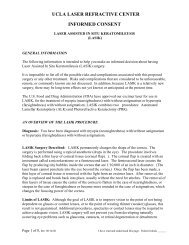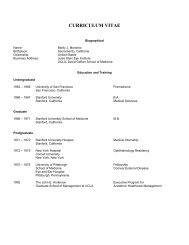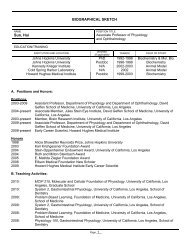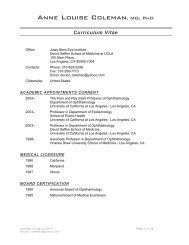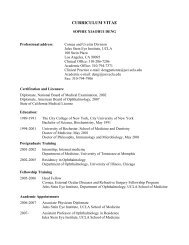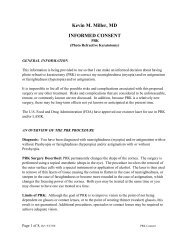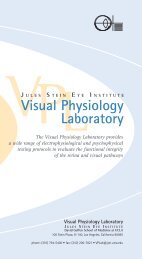View Annual Report - Jules Stein Eye Institute
View Annual Report - Jules Stein Eye Institute
View Annual Report - Jules Stein Eye Institute
You also want an ePaper? Increase the reach of your titles
YUMPU automatically turns print PDFs into web optimized ePapers that Google loves.
Training Programs<br />
The <strong>Jules</strong> <strong>Stein</strong> <strong>Eye</strong> <strong>Institute</strong> and the UCLA<br />
Department of Ophthalmology jointly provide comprehensive<br />
training in ophthalmology and vision science to<br />
medical students, residents, and clinical and research<br />
fellows. The programs encompass the gamut of<br />
ophthalmic and vision science education, representing<br />
every level of training and incorporating a full range of<br />
subjects in the study of the eye. The residency program<br />
is rated one of the top in the country. A large<br />
patient population with diverse vision problems offers<br />
innumerable training opportunities for both residents<br />
and clinical fellows. The availability of more than<br />
15 research laboratories ensures a wide choice of<br />
vision-science projects for all trainees. Predoctoral and<br />
postdoctoral research fellows particularly benefit from<br />
the wealth of new and unfolding research generated by<br />
vision scientists at the <strong>Institute</strong>.<br />
UCLA Medical Student Program<br />
Each academic year, the Department of Ophthalmology<br />
and the <strong>Institute</strong> extend instruction to UCLA medical<br />
students in their second, third, and fourth years of<br />
enrollment. Through lectures, demonstrations, discussions,<br />
and clinical practice, the students have numerous<br />
training opportunities from which to gain knowledge<br />
and experience in ophthalmology.<br />
All second-year medical students participate in a<br />
four-day program that encompasses the ophthalmology<br />
portion of Fundamentals of Clinical Medicine. Third-year<br />
medical students complete a one-week rotation in<br />
ophthalmology, and the fourth-year medical student<br />
program is made up of various elective programs.<br />
Elective courses provide intensive exposure to clinical<br />
ophthalmology and basic visual sciences.<br />
<strong>Jules</strong> <strong>Stein</strong> <strong>Eye</strong> <strong>Institute</strong> residents practice cataract surgery<br />
techniques at Alcon Laboratories.<br />
86 Programs | Training Programs<br />
Medical Student Research Program<br />
At the <strong>Jules</strong> <strong>Stein</strong> <strong>Eye</strong> <strong>Institute</strong>, medical students have<br />
taken clinical and laboratory research electives for<br />
decades; however, there has been no formal program<br />
wherein a medical student could obtain salary and<br />
research support. The Medical Student Research<br />
Program allows select medical students to familiarize<br />
themselves with laboratory or clinical vision science<br />
research, in the hopes that this will enhance their desire<br />
to undertake a career in ophthalmology, with a focus on<br />
academic ophthalmology. Each year, a committee selects<br />
one or two medical student researchers to receive salary<br />
and research support for 6–12 months in the laboratory<br />
or clinical research area of the student’s mentor. The<br />
goal of the program is to encourage medical students<br />
to pursue careers in academic ophthalmology.<br />
UCLA Ophthalmology<br />
Residency Program<br />
The Department of Ophthalmology conducts an accredited<br />
three-year residency program for 24 residents;<br />
eight new residents begin training each July. The full<br />
breadth of ophthalmology training is offered, including<br />
experience in general ophthalmology and ophthalmic<br />
subspecialties. Training incorporates the resources of<br />
the UCLA <strong>Jules</strong> <strong>Stein</strong> <strong>Eye</strong> <strong>Institute</strong>, Harbor-UCLA<br />
Medical Center, Olive <strong>View</strong>-UCLA Medical Center, and<br />
the Veterans Affairs Greater Los Angeles Healthcare<br />
System at West Los Angeles and Sepulveda. Every<br />
resident has exposure to each medical center during<br />
the course of training, thereby ensuring clinical experience<br />
with a wide range of problems and patient<br />
populations. Certification by the American Board of<br />
Ophthalmology is a natural objective of the program.<br />
Clinical Rotations<br />
Clinical rotations at the <strong>Jules</strong> <strong>Stein</strong> <strong>Eye</strong> <strong>Institute</strong> include<br />
both general ophthalmology and subspecialties. In<br />
general, ophthalmology residents work as a team,<br />
handling clinics, emergencies, and walk-in patients.<br />
They also serve as an ophthalmology consult service<br />
for inpatients in the UCLA Medical Center. Residents<br />
assigned to subspecialty service rotations are provided<br />
with intensive exposure to the various divisions within<br />
the Department, working closely with faculty members<br />
in a private practice environment. At the UCLA-affiliated<br />
medical centers, residents work in teams that provide<br />
both general and subspecialty patient care.




